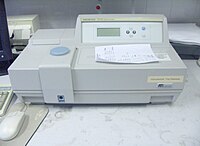
Photo from wikipedia
Perturbations of rainwater chromophoric dissolved organic matter (CDOM) fluorescence induced by changes in rainfall intensity and pH were investigated by field observations and laboratory pH titrations. Microbial humic-like fluorophores dominated… Click to show full abstract
Perturbations of rainwater chromophoric dissolved organic matter (CDOM) fluorescence induced by changes in rainfall intensity and pH were investigated by field observations and laboratory pH titrations. Microbial humic-like fluorophores dominated the rainwater CDOM pool, followed by tryptophan-like and tyrosine-like substances. Increased rainfall intensity had notable dilution effects on all six fluorescent components (C1-C6) identified using parallel factor (PARAFAC) analysis, the effect being especially pronounced for the microbial humic-like C1, tryptophan-like C3, and tyrosine-like C5. The results also indicated that increasing pH from 7 to 9 led to decreased fluorescence intensity (Fmax) of all the six components, while a pH increase from 5 to 7, resulted in increasing Fmax of terrestrial humic-like C2, tyrosine-like C5, and tryptophan-like C6 and decreasing microbial humic-like C1, tryptophan-like C3, and fulvic-like C4. Two-dimensional correlation spectroscopy (2D-COS) demonstrated that synchronous fluorescence responded first to pH modifications at fulvic-like wavelength (λEx/λEm = ∼316/416 nm), followed by tyrosine-like wavelength (λEx/λEm = ∼204/304 nm), tryptophan-like wavelength (λEx/λEm = ∼226/326 nm), microbial humic-like wavelength (∼295/395 nm), and finally terrestrial humic-like wavelength (∼360/460 nm). Our results suggest that a decrease in areas affected by acid rain in South China occurring at present may possibly result in apparent compositional changes of CDOM fluorescence. The decreased rainfall in South-West China and increased rainfall in North-West China during the past five decades may possibly accordingly result in increased and decreased Fmax of all the six components identified in South-West and North-West China, respectively.
Journal Title: Environmental pollution
Year Published: 2017
Link to full text (if available)
Share on Social Media: Sign Up to like & get
recommendations!